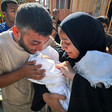The Electronic Intifada 14 October 2022
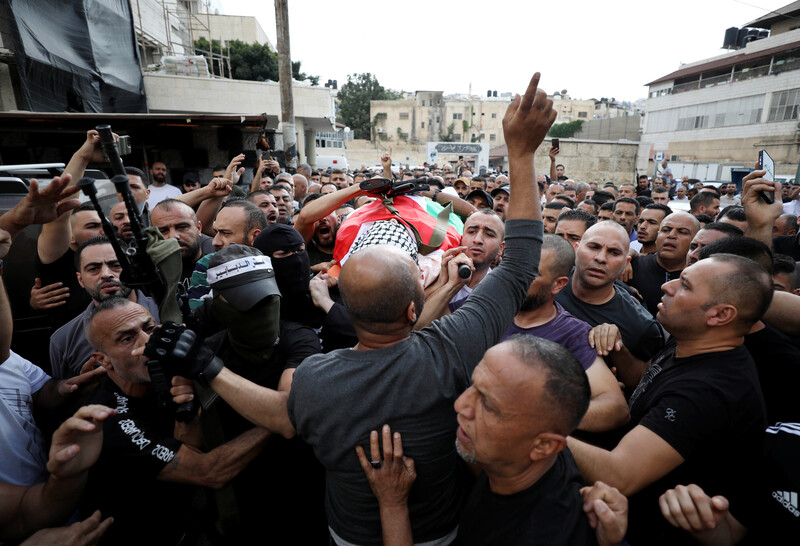
Palestinian mourners carry the body of Abdallah Abu al-Teen during the slain doctor’s funeral in Jenin refugee camp on 14 October.
APA imagesEvents in the occupied West Bank over the past week indicate that the Palestinian liberation struggle, and Israel’s efforts to repress it with with brutal violence, have entered a new phase.
In this looming scenario, the formerly extremist fringe settlers see themselves represented at the top levels of Israeli government, emboldened and beyond the restraint of the army.
Meanwhile, the Palestinian Authority is proving increasingly ineffective at quelling armed resistance and teetering on what some Israeli analysts fear is the verge of collapse.
The PA exists to serve as an enforcement arm of the Israeli occupation and its presence would not be missed by many Palestinians except for those who are currently on its payroll.
But in a situation of complete Israeli impunity, and only empty gestures by international parties towards a nonexistent peace process, the grim statistic of more than 100 Palestinians killed in the West Bank so far this year foretells the even worse violence likely to come.
Despite the Israeli brutality – indeed, because of it – Palestinians have risen up in defense of their existence on their land, with as much fearlessness and determination as every previous generation.Palestinian neighborhoods in Jerusalem have been transformed into battlegrounds this week, with residents burning tires and dumpsters, throwing firecrackers at raiding Israeli forces and even lighting police vehicles on fire:
Israeli settlers, some of them armed, streamed into Sheikh Jarrah, an East Jerusalem neighborhood they seek to take over, on Thursday night and attacked Palestinian residents and their property. In this video, Jawad Burqan, a resident of Sheikh Jarrah, describes how people in the neighborhood, including members of his family, are constantly harassed by settlers who invade the neighborhood and indiscriminately fire weapons: The settlers were apparently led by Israeli lawmaker Itamar Ben-Gvir, who brandished a pistol and told the vigilantes that if Palestinians “throw stones, shoot them.” Ben-Gvir, an ally of former prime minister Benjamin Netanyahu (who seeks to make a comeback in next month’s Israeli election), once proclaimed Baruch Goldstein as his hero.Goldstein was a Jewish settler from Brooklyn who shot to death 29 Palestinian men and boys as they prayed at Hebron’s Ibrahimi mosque during Ramadan in 1994.
After that massacre, Israeli forces partitioned the holy site and shuttered the formerly bustling adjacent Old City.
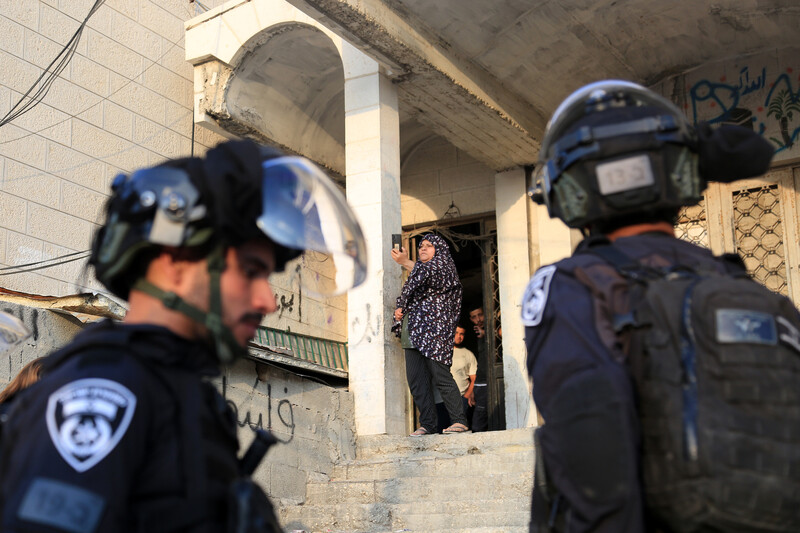
Israeli occupation forces deploy in the East Jerusalem neighborhood of Sheikh Jarrah during a solidarity rally on 14 October.
ActiveStillsPalestinians fear that without determined resistance, Israel will seize any opportunity to impose similar measures at al-Aqsa mosque in Jerusalem, where tensions are rising due to provocative, record-breaking visits by Jewish extremists who seek to change the status quo at the holy site during the Jewish holidays.
Violence in Jerusalem this week must be understood as part of Israel’s wider efforts to erase Palestinian life from the city.
After the settler mob dispersed from Sheikh Jarrah on Thursday, Israeli police fired water smelling of sewage on Palestinian homes in the neighborhood:
Settlers meanwhile attacked Palestinians in Huwwara, a town near Nablus in the northern West Bank, on Friday for a second consecutive day: Haaretz, a Tel Aviv newspaper, reported that settlers attacked Palestinian shopkeepers and threw stones at homes in Huwwara.“The Israeli army later arrived and shot two Palestinians, who are being treated for their wounds,” Haaretz added, citing the Palestine Red Crescent Society.
Video shows settlers attacking businesses in Huwwara under the protection of Israeli soldiers on Thursday:
The surge in confrontations across the West Bank this week was precipitated by Israel’s closure of Shuafat refugee camp, as well as the nearby East Jerusalem neighborhoods of Dahiyat al-Salam, Ras Shahda, Ras Khamis and Anata, since Saturday night.Already surrounded by Israel’s wall and cut off from the rest of the city, the neighborhoods were under a state of siege for several days following the fatal shooting of a soldier at Shuafat checkpoint late Saturday.
Israel was purportedly looking for the suspected shooter, a 21-year-old resident of Shuafat refugee camp.
On Tuesday, Palestinians in the camp announced a general strike and a campaign of civil disobedience in protest of the severe Israeli restrictions, which prevented residents from accessing work, healthcare and schools and bringing life to a standstill.
Adalah, a Palestinian human rights group, said that the “sweeping collective punishment including power cuts, spraying of foul-smelling ‘skunk’ water, and firing of tear gas in densely populated civilian areas” was in violation of the Fourth Geneva Convention.
The closure violated “the freedom of movement of some 130,000 Palestinian residents,” Adalah added.
Israel issued instructions to ease those measures on Thursday in an effort to defuse the situation and on Friday, Palestinians in the camp reportedly announced the suspension of the civil disobedience campaign.
But by Friday night, it seemed that the severe movement restrictions had been reimposed:
For all the upheaval caused, Israeli forces still haven’t managed to capture Palestinians wanted for shooting and killing soldiers in two separate instances in Jerusalem and Nablus, which was also subjected to closure, since Saturday.It would seem that Israel has all but lost control of both cities as a whole, in addition to Jenin, where occupation forces shot and killed two Palestinians on Friday.
Both Nablus and Jenin have re-emerged as centers of armed resistance to the Israeli military occupation. In recent months, Israel and the Palestinian Authority have stepped up their attacks in these areas amid concerns among Israeli leaders that they are slipping out of the occupation’s grip.
For Israel, the nightmare scenario – one that appears to be becoming reality – is that the Palestinian Authority collapses or ceases to function as an auxiliary police force.
In that case, Israeli forces would have to be deployed directly in major Palestinian population centers, as they were during the first intifada prior to the signing of the 1993 Oslo accords which created the PA.
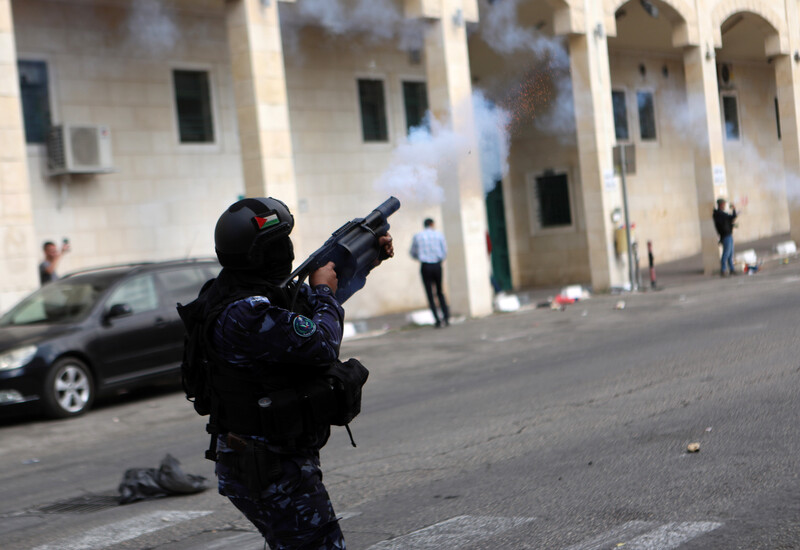
Palestinian Authority security forces fire crowd control weapons as Hamas supporters hold a demonstration in the West Bank city of Hebron on 14 October.
APA imagesIf that were to happen, the confrontations in East Jerusalem would be just a tiny taste of what would likely be a full-scale Palestinian revolt across the West Bank.
The level of violence and brutality that Israel would have to deploy in an effort to crush such a revolt is unthinkable. And if sustained, it could be even more costly to Israel in terms of international support than its regular spasms of killing in Gaza.
And as was seen in May 2021, the confrontations would not necessarily be contained to the West Bank, including East Jerusalem, and Gaza.
At least one Israeli commentator for the influential newspaper Haaretz expressed fear that the current unrest in Nablus, Jenin and East Jerusalem “will slither across the Green Line again, including possible clashes in the mixed (Jewish-Arab) cities.”
Another writer for the same publication likened it to “the terrible feeling of a car hurling down the slope toward an abyss,” offering only prayer as a prescription because ending the structural causes of violence, principally Israel’s supremacist settler-colony regime, is beyond imagination.
For these writers, the fear is that Jewish Israeli communities might be affected by the violence that Palestinians on both sides of the Green Line are subjected to on a daily basis.
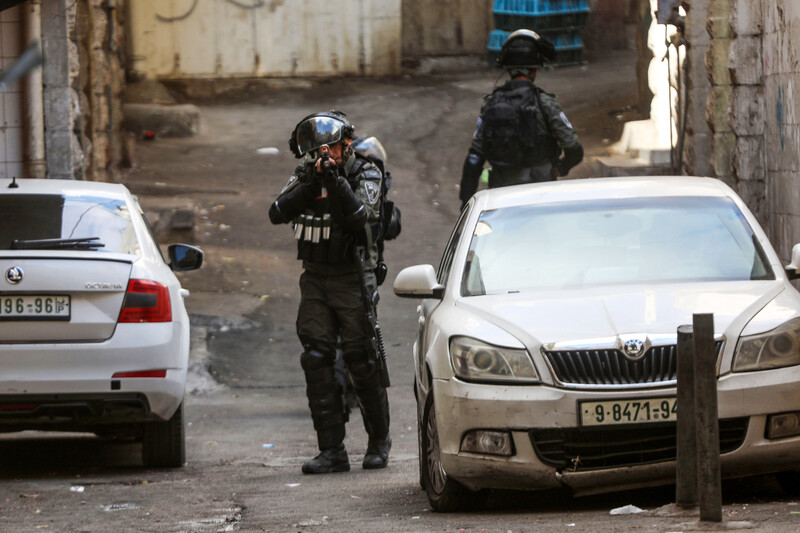
Israeli occupation forces take position during confrontations with Palestinians in the West Bank city of Hebron on 14 October.
APA imagesJenin has endured almost daily raids after a string of deadly attacks in Israel by Palestinians from the area in March.
Around 40 Palestinians in the Jenin area have been killed so far this year.
One of those killed during an Israeli raid in Jenin on Friday was Abdallah Abu al-Teen, a 43-year-old doctor. The Palestinian Authority health ministry said that Abu al-Teen was shot in the head by soldiers in front of a government hospital in the northern West Bank city.
Israeli authorities suggested that Abu al-Teen may have been killed by armed Palestinians and then claimed that the doctor was engaged in a firefight with soldiers when he was killed.
The shifting narrative is similar to that proffered by Israel in the hours and days after Shireen Abu Akleh was killed in the same city.
Several investigations in the months following Abu Akleh’s death found that the Al Jazeera journalist was shot by Israeli troops when there were no armed Palestinians present or confrontations occurring.
The research group Forensic Architecture and Palestinian human rights group Al-Haq stated last month that their investigation, which involved spatial imaging and reconstructions of the incident, shows that Abu Akleh and her colleagues were deliberately targeted. No Israeli soldier has been held criminally liable for her death.
The other Palestinian killed in Jenin on Friday was identified as Mateen Dabaya, in his twenties. Al Jazeera, citing the Palestinian health ministry, reported that Dabaya was shot with a bullet to the head.Also on Friday, a third Palestinian from Jenin, 17-year-old Muhammad Maher Ghawadreh, died in Israeli detention from injuries sustained last month:
Ghawadreh was being detained at an Israeli hospital while being treated for injuries sustained while he allegedly carried out a shooting attack on a bus carrying Israeli soldiers in the West Bank’s Jordan Valley in early September.Seven were injured in the attack that Israeli authorities said was carried out by two others in addition to Ghawadreh, all members of the same family.
Maher Ghawadreh, Muhammad’s father, was present with the father of Raed and Abdalrahman Khazem at the funeral of Mateen Dabaya in Jenin on Friday:
The elder Ghawadreh, remarkably seen openly and armed in public on Friday, is also wanted by Israel for allegedly carrying out the shooting attack in the Jordan Valley in September.Israeli raids and Palestinian resistance were ongoing in various points across the West Bank, including East Jerusalem, late Friday.
Palestinian gunmen reportedly opened fire at Beit El settlement, near the West Bank city of Ramallah, on Friday, lightly injuring an Israeli man.
Israeli media reported that an alleged Palestinian assailant was shot and killed by troops as he attempted to flee.
Meanwhile, video showed Israeli police beating and detaining Palestinians in Sheikh Jarrah as confrontations were ongoing in East Jerusalem:
The siege on Shuafat this week united Palestinians across East Jerusalem, where long-simmering frustration was already high due to a daily atmosphere of repression as Israel seeks to crush Palestinian life in the city.Earlier this year, history-making masses of Palestinians accompanied journalist Shireen Abu Akleh’s coffin during her funeral procession after she was shot and killed by Israeli forces in Jenin refugee camp in May.
Sheikh Jarrah resident and writer Muhammad El-Kurd described the huge mobilization for Abu Akleh’s funeral, despite Israel’s restrictions on public gathering, as “a reclamation of public space” in the city.
The events in Jerusalem this week will likely be remembered as something similar.
Ali Abunimah is executive director and Maureen Clare Murphy is senior editor of The Electronic Intifada.


